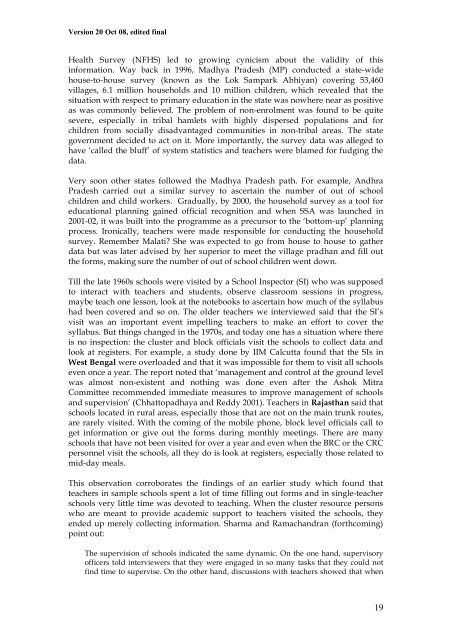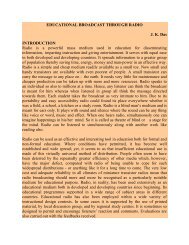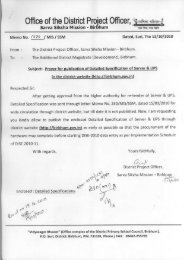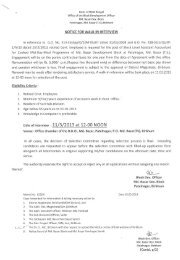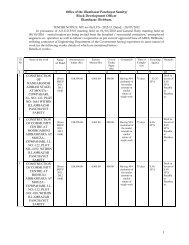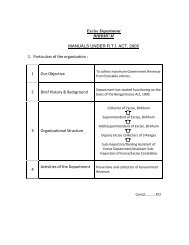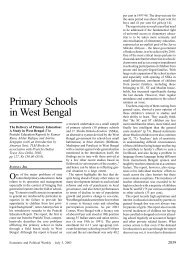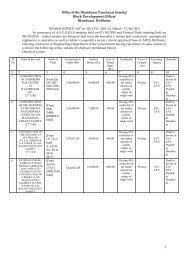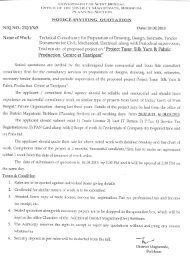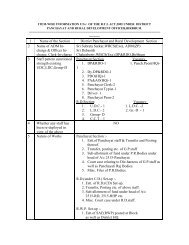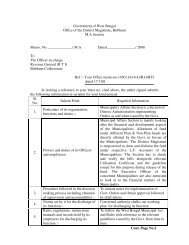Version 20 Oct 08, edited finalAccording to <strong>the</strong> National University <strong>of</strong> Educational Planning <strong>and</strong> Administration(NUEPA), <strong>the</strong> institution that houses DISE, at <strong>the</strong> time <strong>of</strong> initiating DPEP in 1994, itwas felt that a sound information system was essential for <strong>the</strong> successful monitoring<strong>and</strong> implementation <strong>of</strong> <strong>the</strong> programme. It was stressed that DPEP, with a focus ondecentralised planning, required up-to-date <strong>and</strong> reliable <strong>school</strong> level information. In1994, <strong>the</strong> Ministry <strong>of</strong> Human Resource Development (MHRD) decided to design <strong>and</strong>develop a <strong>school</strong>-based computerised information system as a part <strong>of</strong> <strong>the</strong> DPEPnational endeavour, <strong>the</strong> main responsibility for which was entrusted to <strong>the</strong> NationalInstitute <strong>of</strong> Educational Planning <strong>and</strong> Administration (NIEPA), New Delhi.Information on <strong>the</strong> following key variables over a period <strong>of</strong> time is now available at<strong>school</strong>, cluster, block, district, state <strong>and</strong> national levels:- Key data on elementary education in terms <strong>of</strong> <strong>the</strong> number <strong>of</strong> <strong>school</strong>s, enrolment,<strong>and</strong> <strong>teachers</strong>, classified by <strong>school</strong> category <strong>and</strong> <strong>school</strong> management (also inrespect <strong>of</strong> a few variables in case <strong>of</strong> rural/urban areas).- Grade-wise <strong>and</strong> level-wise enrolment in each state.- Examination results for <strong>the</strong> previous academic session for <strong>the</strong> terminal classes at<strong>primary</strong> (Class 4 or 5) <strong>and</strong> upper <strong>primary</strong> (Class 6 or 7) levels <strong>of</strong> education.- Classrooms categorised into good condition, requiring minor <strong>and</strong> major repairsby <strong>school</strong> category.- Number <strong>of</strong> <strong>school</strong>s by category <strong>and</strong> by type <strong>of</strong> building.- Sex-wise enrolment <strong>of</strong> children with disabilities at <strong>primary</strong> <strong>and</strong> upper <strong>primary</strong>levels.- Gender <strong>and</strong> caste distribution <strong>of</strong> regular <strong>and</strong> para-<strong>teachers</strong> <strong>and</strong> <strong>the</strong> proportion <strong>of</strong><strong>teachers</strong> undergoing in-service teacher-training during <strong>the</strong> previous year.- Distribution <strong>of</strong> regular <strong>and</strong> para-<strong>teachers</strong> by educational <strong>and</strong> pr<strong>of</strong>essionalqualifications <strong>and</strong> by <strong>school</strong> category.- Enrolment by medium <strong>of</strong> instruction <strong>and</strong> by <strong>school</strong> category.- Sex-wise number <strong>of</strong> students benefited by various incentive schemes at <strong>primary</strong><strong>and</strong> upper <strong>primary</strong> levels.- Performance indicators in terms <strong>of</strong> <strong>school</strong> category; ratio <strong>of</strong> <strong>primary</strong> to upper<strong>primary</strong> <strong>school</strong>s/sections; enrolment distribution: total, Scheduled Castes <strong>and</strong>Scheduled Tribes, percentage female enrolment; gender-parity index; classrooms;single-teacher <strong>school</strong>s; <strong>school</strong>s with attached pre-<strong>primary</strong> classes; percentage <strong>of</strong>under-age <strong>and</strong> over-age children in <strong>primary</strong> <strong>and</strong> upper <strong>primary</strong> classes; apparentsurvival rate (up to Grade 5), drop out rate, retention rate <strong>and</strong> transition ratefrom <strong>primary</strong> to upper <strong>primary</strong> level.- Quality indicators according to category <strong>of</strong> <strong>school</strong>s, teacher-pupil ratio;availability <strong>of</strong> female <strong>teachers</strong>; <strong>school</strong>s without female <strong>teachers</strong>, blackboard <strong>and</strong>building; percentage <strong>school</strong>s received <strong>and</strong> utilised <strong>school</strong> development <strong>and</strong> TLMgrant; student-classroom ratio; availability <strong>of</strong> drinking water, common toilet <strong>and</strong>girl’s toilet in <strong>school</strong>, etc.By any reckoning this list is quite impressive. During August <strong>and</strong> September everyyear <strong>school</strong>s are expected to send information in specified formats to <strong>the</strong>ir cluster.This information is collated <strong>and</strong> sent to <strong>the</strong> block <strong>and</strong> <strong>the</strong>n to <strong>the</strong> district, <strong>the</strong> state<strong>and</strong> finally to NUEPA.Almost everyone engaged in education has found this information valuable. Yet,during <strong>the</strong> DPEP days <strong>the</strong>re was a lot <strong>of</strong> debate on <strong>the</strong> reliability <strong>of</strong> this data, <strong>and</strong>comparisons between <strong>the</strong> results <strong>of</strong> ‘system statistics’ <strong>and</strong> those <strong>of</strong> sample surveyslike <strong>the</strong> National Sample Survey Organisation (NSSO) <strong>and</strong> <strong>the</strong> National Family18
Version 20 Oct 08, edited finalHealth Survey (NFHS) led to growing cynicism about <strong>the</strong> validity <strong>of</strong> thisinformation. Way back in 1996, Madhya Pradesh (MP) conducted a state-widehouse-to-house survey (known as <strong>the</strong> Lok Sampark Abhiyan) covering 53,460villages, 6.1 million households <strong>and</strong> 10 million children, which revealed that <strong>the</strong>situation with respect to <strong>primary</strong> education in <strong>the</strong> state was nowhere near as positiveas was commonly believed. The problem <strong>of</strong> non-enrolment was found to be quitesevere, especially in tribal hamlets with highly dispersed populations <strong>and</strong> forchildren from socially disadvantaged communities in non-tribal areas. The stategovernment decided to act on it. More importantly, <strong>the</strong> survey data was alleged tohave ‘called <strong>the</strong> bluff’ <strong>of</strong> system statistics <strong>and</strong> <strong>teachers</strong> were blamed for fudging <strong>the</strong>data.Very soon o<strong>the</strong>r states followed <strong>the</strong> Madhya Pradesh path. For example, AndhraPradesh carried out a similar survey to ascertain <strong>the</strong> number <strong>of</strong> out <strong>of</strong> <strong>school</strong>children <strong>and</strong> child workers. Gradually, by 2000, <strong>the</strong> household survey as a tool foreducational planning gained <strong>of</strong>ficial recognition <strong>and</strong> when SSA was launched in2001-02, it was built into <strong>the</strong> programme as a precursor to <strong>the</strong> ‘bottom-up’ planningprocess. Ironically, <strong>teachers</strong> were made responsible for conducting <strong>the</strong> householdsurvey. Remember Malati? She was expected to go from house to house to ga<strong>the</strong>rdata but was later advised by her superior to meet <strong>the</strong> village pradhan <strong>and</strong> fill out<strong>the</strong> forms, making sure <strong>the</strong> number <strong>of</strong> out <strong>of</strong> <strong>school</strong> children went down.Till <strong>the</strong> late 1960s <strong>school</strong>s were visited by a School Inspector (SI) who was supposedto interact with <strong>teachers</strong> <strong>and</strong> students, observe classroom sessions in progress,maybe teach one lesson, look at <strong>the</strong> notebooks to ascertain how much <strong>of</strong> <strong>the</strong> syllabushad been covered <strong>and</strong> so on. The older <strong>teachers</strong> we interviewed said that <strong>the</strong> SI’svisit was an important event impelling <strong>teachers</strong> to make an effort to cover <strong>the</strong>syllabus. But things changed in <strong>the</strong> 1970s, <strong>and</strong> today one has a situation where <strong>the</strong>reis no inspection: <strong>the</strong> cluster <strong>and</strong> block <strong>of</strong>ficials visit <strong>the</strong> <strong>school</strong>s to collect data <strong>and</strong>look at registers. For example, a study done by IIM Calcutta found that <strong>the</strong> SIs inWest Bengal were overloaded <strong>and</strong> that it was impossible for <strong>the</strong>m to visit all <strong>school</strong>seven once a year. The report noted that ‘management <strong>and</strong> control at <strong>the</strong> ground levelwas almost non-existent <strong>and</strong> nothing was done even after <strong>the</strong> Ashok MitraCommittee recommended immediate measures to improve management <strong>of</strong> <strong>school</strong>s<strong>and</strong> supervision’ (Chhattopadhaya <strong>and</strong> Reddy 2001). Teachers in Rajasthan said that<strong>school</strong>s located in rural areas, especially those that are not on <strong>the</strong> main trunk routes,are rarely visited. With <strong>the</strong> coming <strong>of</strong> <strong>the</strong> mobile phone, block level <strong>of</strong>ficials call toget information or give out <strong>the</strong> forms during monthly meetings. There are many<strong>school</strong>s that have not been visited for over a year <strong>and</strong> even when <strong>the</strong> BRC or <strong>the</strong> CRCpersonnel visit <strong>the</strong> <strong>school</strong>s, all <strong>the</strong>y do is look at registers, especially those related tomid-day meals.This observation corroborates <strong>the</strong> findings <strong>of</strong> an earlier study which found that<strong>teachers</strong> in sample <strong>school</strong>s spent a lot <strong>of</strong> time filling out forms <strong>and</strong> in single-teacher<strong>school</strong>s very little time was devoted to teaching. When <strong>the</strong> cluster resource personswho are meant to provide academic support to <strong>teachers</strong> visited <strong>the</strong> <strong>school</strong>s, <strong>the</strong>yended up merely collecting information. Sharma <strong>and</strong> Ramach<strong>and</strong>ran (forthcoming)point out:The supervision <strong>of</strong> <strong>school</strong>s indicated <strong>the</strong> same dynamic. On <strong>the</strong> one h<strong>and</strong>, supervisory<strong>of</strong>ficers told interviewers that <strong>the</strong>y were engaged in so many tasks that <strong>the</strong>y could notfind time to supervise. On <strong>the</strong> o<strong>the</strong>r h<strong>and</strong>, discussions with <strong>teachers</strong> showed that when19
- Page 5 and 6: Version 20 Oct 08, edited finalIWhy
- Page 7 and 8: Version 20 Oct 08, edited finalThis
- Page 9 and 10: Version 20 Oct 08, edited finalIISh
- Page 11 and 12: Version 20 Oct 08, edited finalwant
- Page 13 and 14: Version 20 Oct 08, edited finalWhy
- Page 15 and 16: Version 20 Oct 08, edited finalallo
- Page 17: Version 20 Oct 08, edited finalfor
- Page 21 and 22: Version 20 Oct 08, edited finalcomm
- Page 23 and 24: Version 20 Oct 08, edited finalLet
- Page 25 and 26: Version 20 Oct 08, edited final(two
- Page 27 and 28: Version 20 Oct 08, edited finalThe
- Page 29 and 30: Version 20 Oct 08, edited finalIIIW
- Page 31 and 32: Version 20 Oct 08, edited finalstat
- Page 33 and 34: Version 20 Oct 08, edited finalunde
- Page 35 and 36: Version 20 Oct 08, edited final- Th
- Page 37 and 38: Version 20 Oct 08, edited finalIVBe
- Page 39 and 40: Version 20 Oct 08, edited finalOver
- Page 41 and 42: Version 20 Oct 08, edited finallate
- Page 43 and 44: Version 20 Oct 08, edited finalNotw
- Page 45 and 46: Version 20 Oct 08, edited finalwas
- Page 47 and 48: Version 20 Oct 08, edited finalacco
- Page 49 and 50: Version 20 Oct 08, edited finalscho
- Page 51 and 52: Version 20 Oct 08, edited finalVTra
- Page 53 and 54: Version 20 Oct 08, edited finalques
- Page 55 and 56: Version 20 Oct 08, edited final1994
- Page 57 and 58: Version 20 Oct 08, edited finalimpr
- Page 59 and 60: Version 20 Oct 08, edited finalBox
- Page 61 and 62: Version 20 Oct 08, edited finaladmi
- Page 63 and 64: Version 20 Oct 08, edited finalTrai
- Page 65 and 66: Version 20 Oct 08, edited finalhelp
- Page 67 and 68: Version 20 Oct 08, edited final(Kin
- Page 69 and 70:
Version 20 Oct 08, edited finalinst
- Page 71 and 72:
Version 20 Oct 08, edited finalfund
- Page 73 and 74:
Version 20 Oct 08, edited finalCrea
- Page 75 and 76:
Version 20 Oct 08, edited finalBIBL
- Page 77 and 78:
Version 20 Oct 08, edited finalDe,
- Page 79 and 80:
Version 20 Oct 08, edited finalGove
- Page 81 and 82:
Version 20 Oct 08, edited finalKuma
- Page 83 and 84:
Version 20 Oct 08, edited final____
- Page 85 and 86:
Version 20 Oct 08, edited finalSyno
- Page 87 and 88:
Version 20 Oct 08, edited finalSC:


